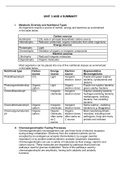UNIT 3 AND 4 SUMMARY
I. Metabolic Diversity and Nutritional Types
All organisms require a source of carbon, energy and electrons as summarized
in the table below:
Carbon sources
Autotrophs CO2 sole or principal biosynthetic carbon source.
Heterotrophs Reduced, preformed, organic molecules from other organisms
Energy sources
Phototrophs Light
Chemotrophs Oxidation of organic or inorganic compounds
Electron sources
Lithotrophs Reduced inorganic molecules
Organotrophs Organic molecules
Most organisms can be placed into one of five nutritional classes as summarized
in the table below:
Nutritional type Carbon Energy Electron Representative
source source source Microorganisms
Photolithautotroph CO2 Light Inorganic Purple and green sulphur
electron donor bacteria, cynobacteria and
diatoms
Photoorganoheterotrop Organic Light Organic Purple non sulphur bacteria,
h carbon electron donor green sulphur bacteria
Chemolithautotroph CO2 Inorganic Inorganic Sulphur-oxidizing bacteria,
chemicals electron donor hydrogen-oxidizing bacteria,
methanogens, nitrifying
bacteria, iron-oxidizing
bacteria
Chemolithoheterotroph Organic Inorganic Inorganic Some sulphur –oxidizing
carbon chemicals electron donor bacteria (e.g. Beggiatoa)
Chemoorganoheterotro Organic Organic Organic Most nonphotosynthetic
ph carbon chemicals, electron donor, microbes, including most
often same often same as pathogens, fungi and many
as C C source protists and archaea
source
II. Chemoorganotrophic Fueling Processes
Chemoorganotrophic microorganisms can use three kinds of electron acceptors
during energy metabolism. Electrons from the oxidized nutrients can be
accepted by an endogenous acceptor (fermentation), by oxygen (aerobic
respiration) or by another external electron acceptor (anaerobic respiration).
Chemoorganotrophs can use a variety of molecules as their energy, electron and
carbon source. These molecules are degraded by pathways that funnel into
pathways used for glucose metabolism. Some of the pathways used by
chemoorganotrophs are amphibolic, having both catabolic and anabolic
functions
, III. Aerobic Respiration -it completely catabolizes organic energy sources to
carbon dioxide using oxygen as the terminal electron acceptor; reducing power
derives from the glycolytic and TCA pathways.
IV.From Glucose to Pyruvate
A. The Embden-Meyerhof Pathway
1. The most common pathway for glucose degradation (glycolysis), it is
found in all major groups of microorganisms
2. Functions in the presence or absence of oxygen and is divided into two
parts:
a. In the 6-carbon stage, glucose is phosphorylated twice to yield
fructose 1,6-bisphosphate; this requires the expenditure of two
molecules of ATP
b. The 3-carbon stage cleaves fructose 1,6-bisphosphate into two 3-
carbon molecules, which are each oxidized to pyruvate; two
molecules of ATP are produced by substrate-level phosphorylation
from each of the 3-carbon molecules for a net yield of two molecules
of ATP; two molecules of NADH are also produced per glucose
molecule
B. The Entner-Doudoroff pathway is an alternative glycolytic pathway used by
some microbes; the 6-carbon stage begins with only one phosphorylation
event with phosphogluconate as an intermediate with one pyruvate and one
glyceraldehyde 3-phosphate produced; the 3-carbon stage is the same as
the Embden-Meyerhof pathway
C. The pentose phosphate pathway
1. Known as the hexose monophosphate pathway; produces a variety of
3-, 4-, 5-, 6-, and 7-carbon sugar phosphates
2. Has several catabolic and anabolic functions (amphibolic)
a. Production of NADPH, which serves as a source of electrons for
biosynthetic processes
b. Production of 4- and 5-carbon skeletons that can be used for the
synthesis of amino acids, nucleic acids, and other macromolecules
c. Complete catabolism of hexoses and pentoses, yielding ATP and
NADH (made by converting NADPH to NADH)
V.Tricarboxylic Acid Cycle
A. Pyruvate can be oxidized to carbon dioxide by the tricarboxylic acid (TCA)
cycle (or Krebs cycle) after first being converted to acetyl-CoA; this
preliminary reaction is accompanied by the loss of one carbon atom as
carbon dioxide and produces NADH
B. Acetyl-CoA reacts with oxaloacetate (a 4-carbon molecule) to produce a 6-
carbon molecule (citric acid), which is subsequently oxidized to release two
molecules of carbon dioxide, regenerating the oxaloacetate. During this
process, the following occur:
1. ATP (as GTP) is produced by substrate-level phosphorylation
2. Three molecules of NADH and one molecule of FADH 2 are produced




